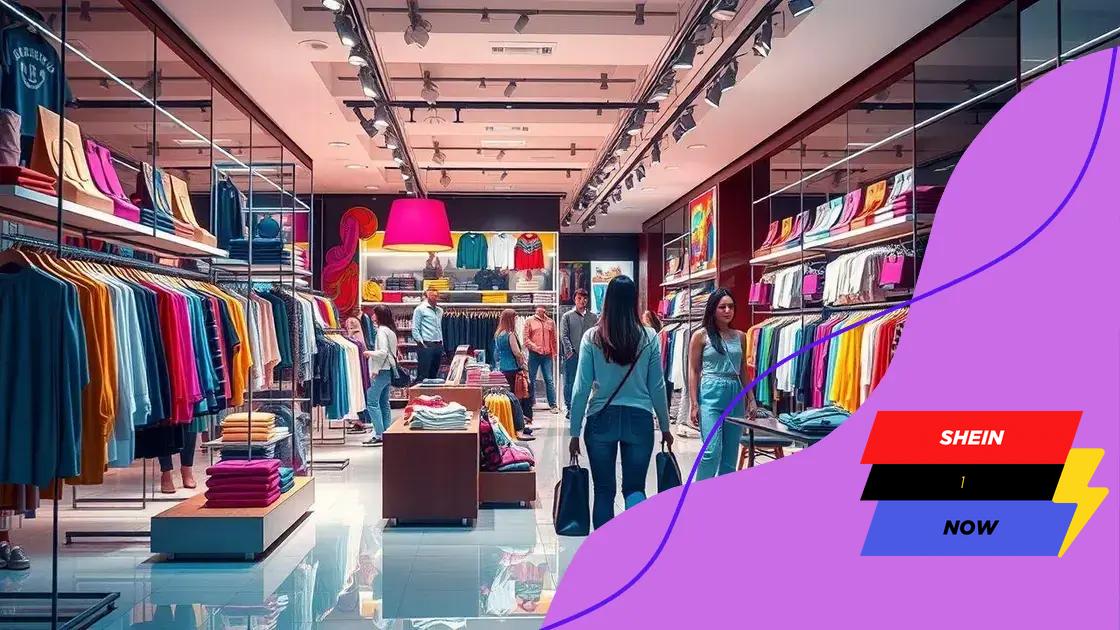Shein’s impact on fast fashion industry standards

Shein’s impact on fast fashion industry standards includes rapid production and low costs, leading to significant environmental and ethical challenges, while prompting a shift toward sustainable practices among brands.
Shein’s impact on fast fashion industry standards is undeniable, as it continues to shape trends and consumer choices. Have you noticed how quickly styles change these days? This article explores the nuances behind this rapid shift.
Understanding Shein’s business model
Understanding Shein’s business model provides insight into how this brand has rapidly become a leader in the fast fashion industry. With its unique approach, Shein has redefined how consumers interact with clothing.
Key Features of Shein’s Model
Shein operates on a highly responsive system that focuses on quick production and low prices. This allows the company to stay ahead of trends and meet consumer demands swiftly. Additionally, Shein offers a vast range of products—often launching new styles daily—keeping the inventory fresh and engaging.
- Low-cost production methods.
- Rapid design-to-sale timelines.
- Extensive use of social media for marketing.
- Frequent collaborations with influencers.
Unlike traditional retailers, Shein relies heavily on data analytics to identify trends and consumer preferences. By analyzing purchasing behaviors, the company can predict what styles will become popular. This data-driven approach also enables Herin to target specific demographics with tailored marketing strategies.
Challenges and Criticisms
Despite its success, Shein faces criticism regarding labor practices and sustainability issues. Concerns about working conditions in factories and the environmental impact of producing so much low-cost fashion are ongoing. Addressing these challenges is essential for Shein’s long-term success in a market that’s increasingly valuing ethical practices.
In conclusion, understanding Shein’s business model reveals the innovative strategies that have fueled its growth. However, the brand must also navigate the complexities of ethics and sustainability to maintain its reputation and appeal among consumers who are becoming more conscious of these issues.
The rise of fast fashion: A timeline
The rise of fast fashion has transformed the retail landscape over the past few decades. The timeline of this trend shows how quickly clothing can move from design to consumer.
Early Days of Fast Fashion
The term “fast fashion” became popular in the 1990s as brands started to produce clothes at an incredible pace. Companies like Zara began to change how clothes were designed and sold. They introduced new styles in weeks instead of months.
- 1999: Zara releases new collections every two weeks.
- 2000: H&M emphasizes affordable trendy clothing.
- 2005: Brands start using online sales as a major channel.
With the growth of the internet, fast fashion brands gained more visibility. Shoppers could now see and buy new styles quickly and easily. The convenience of online shopping made it even better for consumers.
Explosive Growth in the 2010s
In the early 2010s, fast fashion took off. Major retailers like Forever 21 and ASOS entered the market. They provided a wide variety of clothing at low prices, appealing to younger shoppers. With social media on the rise, trends exploded overnight as influencers showcased their latest finds.
- 2010: The popularity of social media helps brands reach new audiences.
- 2015: Brands start to face criticism over sustainability and production ethics.
- 2018: Shein becomes a major player in the fast fashion market.
As fast fashion’s popularity grew, so did its challenges. Critics began pointing out the negative effects on the environment and labor practices. Yet, consumers continued to flock to these brands for affordable, trendy options.
By the end of the 2010s, the fast fashion industry grew rapidly, leading to ongoing discussions about its impact on global culture and the economy. The combination of low prices and the constant availability of new styles kept consumers engaged, ensuring that fast fashion was here to stay.
Consumer behavior and fast fashion trends

Consumer behavior and fast fashion trends are closely connected. As society evolves, so do shopping habits and preferences, especially when it comes to fashion.
Impact of Social Media
Social media plays a significant role in shaping consumer behavior. Platforms like Instagram and TikTok showcase the latest trends, making them accessible to countless users. Influencers often highlight fast fashion brands, encouraging followers to adopt new styles. This instant exposure creates a sense of urgency among consumers, pushing them to purchase quickly.
- Trend cycles have shortened from seasons to weeks.
- Consumers are more likely to try new styles based on influencer recommendations.
- Online shopping offers convenience and instant trends.
With the ability to see what peers and celebrities are wearing, shoppers feel pressure to keep up. The fear of missing out (FOMO) drives many decisions, prompting quick purchases rather than thoughtful ones.
Value of Affordability
A major factor in consumer choices is affordability. Fast fashion brands often offer trendy items at low prices, making it easy for consumers to buy more without worrying about the cost. This leads to a throwaway culture, where items are worn only a few times before being discarded.
Many consumers are willing to sacrifice quality for cost when it comes to trendy items. This dynamic keeps fast fashion brands producing low-cost, high-turnover garments that appeal to the youth market.
As consumers become more aware of the implications of their buying habits, some start to question their choices. Concerns about sustainability and ethical production are growing. Shoppers are beginning to look for brands that reflect their values, indicating a shift in consumer behavior.
However, the allure of fast fashion remains strong for many. Convenience, affordability, and the constant cycle of new trends keep consumers engaged and eager to shop.
Sustainability challenges in fast fashion
Sustainability challenges in fast fashion are becoming increasingly prominent as consumers and brands face the impact of the industry’s rapid growth. The fast fashion model prioritizes quick production and low costs, often at the expense of environmental and social responsibilities.
Environmental Impact
The fast fashion industry contributes significantly to environmental degradation. It results in enormous waste, as many garments are discarded after only a few uses. Textile waste has reached alarming levels, with millions of tons ending up in landfills each year.
- Fast fashion contributes to overproduction and consequently, textile waste.
- Water pollution results from dyeing processes and chemical runoff.
- The industry is known for its high carbon footprint due to inefficient practices.
Moreover, the production of clothing consumes massive amounts of water. For instance, producing one cotton shirt can require up to 2,700 liters of water. Given the global water crisis, this issue is highly concerning.
Ethical Concerns
Alongside environmental issues, there are severe ethical concerns surrounding labor practices in the fast fashion sector. Many fast fashion brands are linked to poor working conditions in factories. Workers are often paid low wages and may face unsafe conditions. These issues highlight a significant imbalance in consumerism and ethics.
As awareness of these issues rises, shoppers are beginning to demand more transparency from brands. They want to know where their clothes come from and how they are made. This shift in consumer preference is pressuring brands to adopt more sustainable practices.
Some fast fashion brands are introducing initiatives to improve sustainability, but critics argue that these efforts are often just marketing strategies rather than genuine commitments. Overall, the sustainability challenges in fast fashion raise important questions about the future of the industry.
Future outlook for the fast fashion industry
The future outlook for the fast fashion industry is a topic of great interest as consumers and brands seek a balance between trends and sustainability. The industry faces mounting pressure to evolve, especially in light of environmental and ethical concerns.
Shift Towards Sustainability
As awareness grows about the impact of fast fashion, brands are beginning to adopt sustainable practices. Many companies are now exploring eco-friendly materials and more responsible manufacturing processes. This shift is crucial for attracting conscious consumers who prioritize sustainability.
- Increased use of organic and recycled materials.
- Improvements in supply chain transparency.
- Commitments to reducing carbon footprints.
Some brands are also implementing take-back programs, where customers can return old clothing for recycling or repurposing. These initiatives not only promote sustainability but also engage consumers, creating a more loyal customer base.
Technological Innovations
Technological advancements are poised to reshape the future of fast fashion. Artificial intelligence and data analytics are being used to predict trends and consumer preferences. This allows brands to create products that are more in line with what consumers want, reducing waste associated with overproduction.
Additionally, virtual reality and augmented reality are being explored for online shopping experiences. This technology can provide a more interactive and personalized shopping experience, encouraging customers to buy more efficiently.
However, the challenge remains: can fast fashion maintain its appeal while becoming more sustainable? As more consumers make choices based on ethics and environmental impact, brands must adapt or risk losing their market edge.
Ultimately, the future of the fast fashion industry hinges on its ability to balance speed and style with responsibility. This evolution will determine its long-term success in an increasingly aware and demanding market.
FAQ – Frequently Asked Questions about Fast Fashion and Sustainability
What are the main environmental impacts of fast fashion?
Fast fashion contributes to significant waste, pollution, and high water consumption, leading to serious environmental degradation.
How is consumer behavior changing towards fast fashion?
Consumers are becoming more aware and are demanding sustainable practices, pushing brands to adopt eco-friendly methods.
What initiatives are fast fashion brands taking to improve sustainability?
Many brands are starting to use sustainable materials, implement recycling programs, and enhance transparency in their supply chains.
Will technology play a role in the future of fast fashion?
Yes, technology will likely enhance production efficiency and improve customer experience, making the shopping process more sustainable.





